
Origins of the Halloween Date
The date of many ancient festivals centered on the first of the month, for example, May Day, and Llamas on the 1st of August. However, our ancestors showed advanced thinking in starting the celebrations at midnight. It was not long before they hit upon an even better plan, and that was to start the revelry on the evening before the main festival. Samhain, a Celtic festival to celebrate the new year on the 1st of November, was particularly susceptible to starting on the eve, that is 31st of October.
With the spread of Christianity in the first millennium, Church leaders emphasized the importance of All Saints Day on the 1st of November. This date was also known as All Hallows and gradually, the name for the night before All Hallows changed to Hallow’s Eve, then Hallow e’en, and finally Halloween.
**Samhain – In medieval English ‘mh’ was pronounced ‘w’, hence: Sow-en.
Funny But Clean Halloween Jokes
Let’s start with some of the cleanest Halloween jokes.
- What does a witch ask for in a hotel?
- Broom service.
Funny, Clean Halloween Jokes
Here are some more clean and funny Halloween jokes:
- What would you get if you crossed a vampire and a teacher?
Lots of blood tests! - Why did Dracula’s mother give him cough medicine?
Because he was having a coffin fit. - What did Dr. Frankenstein get when he put a goldfish brain in the body of his dog?
I don’t know, but it is great at chasing submarines. - Why wasn’t there any food left after the monster party?’Cos everyone was a goblin.
- Dracula decided he needed a dog, which breed did he choose?
A bloodhound. - What would you call the ghost of a door-to-door salesman?
A dead ringer. - What do skeletons always order at a restaurant?
Spare ribs! - Who was the most famous French skeleton?
Napoleon bone-apart.
Trip to Walmart
It was mid-October and I was waiting for my wife, Julie, at the checkout at Walmart supermarket in Worcester, Massachusetts, USA, I noticed that someone had left behind their broom.
When no one came to claim it, I went outside to search for a couple I remembered seeing at the cashier’s desk. I spotted them getting into their truck and hurried over.
‘Excuse me,’ I said to the young woman, ‘but did you by any chance leave your broom inside?’ ‘No,’ she retorted quickly and with a smile, ‘we came by truck.’
Clean Halloween Jokes for Kids
Kids are great at telling, devising, and modifying Halloween jokes. Here is Will and Guy’s collection of clean one-liner Halloween jokes to keep your children amused on October 31st.
- What is a vampire’s favorite holiday?
Fangsgiving. - What do skeletons say before they begin dining?
Bone appetite! - What is a ghoul’s favorite drink?
Slime juice - What does Mrs Ghost serve for dessert?
Ice scream. - What do fishermen say on Halloween?
‘Trick-or-trout!’ - Where do spooks go to post a parcel?
The ghost office. - What did the vampire say to the Invisible Man?
‘Long time, no see!’ - Why is Dracula so unpopular?
Because he’s a pain in the neck! - What runs around a cemetery but doesn’t move?
A fence! - Why do demons and ghouls hang out together?
Because demons are a ghoul’s best friend! (Diamonds … Girls!) - What did the mother ghost say to her children?
‘Don’t spook until you’re spooken to.’
Halloween Jokes on Witches
Next, let’s continue with Halloween jokes on witches:
- Why do witches wear name tags?
So that they can tell witch is which! - What do you call a witch who lives at the beach?
A sand-witch. - Why do witches fly on brooms?
Vacuum cleaner cords aren’t long enough. - What do you call a witch’s garage?
A broom closet. - Why don’t angry witches ride their brooms?
They’re afraid of flying off the handle. - What do witches put on their hair?
Scare spray. - What do they teach at Witches School?
Spelling. - When is it bad luck to meet a black cat?
When you’re a mouse. - What does a witch ask for in a hotel?
Broom service.
Ghost, Vampire, Mummy, and Spook Halloween Jokes
Below you’ll find some of the spookiest Halloween jokes:
- What happened when a boy vampire met a girl vampire?
It was love at first bite! - How does a girl vampire flirt?
She bats her eyes. - What did the girl say when a vampire kissed her?
It was a pain in the neck. - What do you call a skeleton who won’t work?
Lazy bones. - What’s a skeleton’s favorite musical instrument?
A trom-bone! - Where do baby ghosts go during the day?
Day Scare Centers. - Why don’t skeletons like parties?
They have no body to dance with. - What was the favorite game at the ghosts’ birthday party?
Hide and shriek. - What do the birds sing on Halloween?
Twick or tweet. - Why do mummies make good employees?
They get all wrapped up in their work. - Who did the ghost invite to his party?
Anyone he could dig up! - Who did Frankenstein take to the prom?
His ghoul friend. - Why did the game warden arrest the ghost?
He didn’t have a haunting license. - How can you tell if a vampire likes baseball?
The night that he goes into a bat. - Where do spooks water ski?
On Lake Erie. - Where do mummies go for a swim?
To the Dead Sea. - What kind of streets do zombies like to haunt?
Dead-end streets. - What has webbed feet, feathers, fangs, and goes quack-quack?
Count duckula. - What’s a monster’s favorite Shakespeare play?
Romeo and ghouliet. - Who does Dracula get mail from?
His fang club. - What do you get when you cross a snowman with a vampire?
Frostbite.
Halloween jokes & Superstitions
Some Halloween jokes are accompanied by superstitions:
John decided to play a trick on his superstitious friend Henry. Now Henry liked a drink at the local pub every Friday night.
One dark night Henry set off for home, meanwhile John hid in the churchyard. The scene was set. Henry staggered on home, as he passed the
churchyard he said out loud, ‘Where am I.’
John, from behind a grave, replied in a sepulchral voice: ‘Ammmongst the living.’
‘Then where are you then?’ asked Henry.
‘Ammmmongst the deeaddd’ wailed John. Henry sobered up and ran home faster than he had ever run before.
Internet Kills the Joke-Telling Star
This one is Will and Guy’s favorite one among these Halloween jokes.
As a boy, the above yarn as told by my Uncle John would enthrall us children on a cold wet autumn night. (We celebrated the 5th of November, not Halloween)
At a distance of 50 years, I find it only moderately amusing. Perhaps I don’t have his intonation and gestures. My final thought is, is the internet killing yarn-telling? Do you ever meet an old codger who can tell an original tall story?
Funny Halloween Jokes from Joe Labatt of Canada
These Halloween jokes come from Joe Labatt.
- In Canada, you design your Halloween costume to fit over a snowsuit.
- Joe says: “We wait for a blizzard before going ‘Trick or treating’ “.
- His best line was: “I use the trunk of my car as a deep freeze.”
Kids Halloween Jokes
Now, we’ll discuss Halloween jokes created for kids:
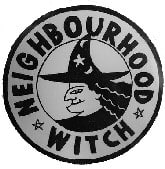
- What’s a monster’s favorite play?
- Romeo and ghouliet
- Why do witches fly on brooms?
- Vacuum cleaner cords aren’t long enough
- What do ghosts serve for dessert?
- Ice scream
- What do you call serious rocks?
- Gravestones.
- What do you call pretend rocks?
- Shamrocks.
Funny Halloween Jokes Pictures
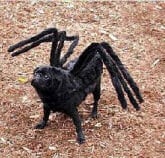
We’ve also got some Halloween jokes on pictures.
When witches go riding, and black cats are seen, the moon laughs and whispers, ’tis near Halloween.
Giant Pumpkin in Hong Kong
This is one of the best Halloween jokes that features a giant pumpkin.
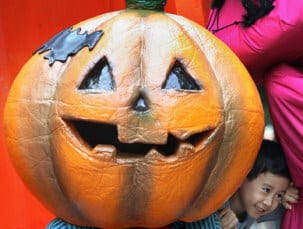
A boy meets a giant pumpkin in Hong Kong. Although Halloween has little meaning to most people on the island the event is seized upon as a marketing opportunity. See more Halloween jokes and stories on pumpkins.
Ghostly Story by Kate Bauer [Innkeeper]
Because of a guest, we have a confirmed ghost story. My husband and I both experienced the same “feeling” and vision while outside working the orchard and blueberries — the funny part is I didn’t tell him about it when it happened (mine happened first and I didn’t tell him, then his occurred some months later and he came in and told me).

My husband came in one day (about a month or so after I had my experience) and told me of his experience. Same man, same “watchful” feeling. We both “saw” this figure in our side vision — a man watching us as we worked.
It also was a “feeling” of this voice telling us where to prune, and how to do the job we were doing.
A “guiding spirit,” we call him.
We found out later that it was Old Man Simon. How did we find out? We described this man to a guest (a relative of the Brewsters, who owned the property before us) who brought pictures of Simon. She showed us the picture only after we described him. It was one of the original owners of this 260-year-old home!
Hell Freezes Over at Halloween

A couple from Hell, Michigan, USA, won a $115,001 [£55,000] lottery prize in the Halloween draw:
John and Sue Wilson are in heaven even though they live in Hell, a town 45 miles west of Detroit. In the Michigan Lottery, they won the big prize in the Fantasy 5 drawing held on Halloween 2007.
‘How cool is that?’ said Sue Wilson, 43, a teacher’s aide. Her husband is an electrician. The couple said they plan to use their winnings to pay off bills, make some home improvements, buy a video game system for their 13-year-old son, and possibly visit relatives in Georgia.
The Origin of Halloween
Halloween is also known as Samhain, Pinkie Night, Soul Cakers, Love Divination, or most aptly – Mischief Night. Halloween and its associated customs have evolved from ancient Celtic celebrations, which honor the dead. The Halloween festival is also intertwined with end-of-harvest celebrations, and in some cultures, All Saints religious elements.
Three Musings on Autumn
- Autumn is a season for big decisions – like whether or not it’s too late to start spring cleaning.
- This autumn we have seen falling leaves and rising gas prices. We’re raking it up while the oil companies are raking it in.
- I got tired of looking at all those leaves in my yard, so I got up off the couch and went into action. I closed the curtains.
More Funny, but Clean Halloween Jokes
Let’s continue with some more clean Halloween jokes:
- What do you call a witch’s garage?
- A broom closet.
- What music do ghosts like the best?
- Haunting melodies.
- Is a drunken ghost a methylated spirit?
Ten Short Halloween Jokes
Here are some more short and funny Halloween jokes:
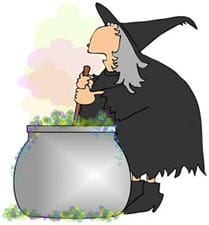
- A grandmother pretends she doesn’t know who you are on Halloween. – Erma Bombeck
- ‘Tis now the very witching time of night, When churchyards yawn and hell itself breathes out Contagion to this world.’ – William Shakespeare
- Hold on, man. We don’t go anywhere with “scary,” “spooky,” “haunted,” or “forbidden” in the title. – Scooby-Doo
- They that are born on Halloween shall see more than other folk. – Anon. [Will and his wife both were born on Halloween]
- As I was going up the stairs, I met a man who wasn’t there He wasn’t there again today… Oh, how I wish he’d go away. Anonymous
- Double, double toil and trouble, Fire burn, and cauldron bubble.- William Shakespeare
- There are three things I have learned never to discuss with people: religion, politics, and the “Great Pumpkin.” – Linus [Charlie Brown]
- Eye of newt, and toe of frog, Wool of bat, and tongue of dog, Adder’s fork, and blind-worm’s sting, Lizard’s leg, and owlet’s wing, For a charm of powerful trouble, Like a hell-broth boil and bubble. – William Shakespeare
- On Halloween, the parents sent their kids out looking like me. – Rodney Dangerfield
- For 2012 Halloween the the most popular mask is the Arnold Schwarzenegger mask. And the best part? With a mouth full of candy you will sound just like him. – Conan O’Brien
Fun Halloween Jokes on Fashion
Will and Guy take a look at Halloween art and fashion and listed them as a part of Halloween Jokes.
Halloween Bone-shaker Costume
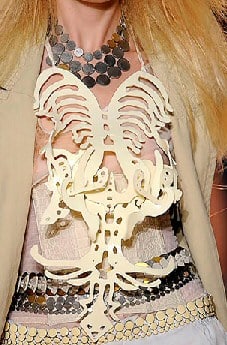
Here is a dose of macabre fashion for Halloween. Top designers gain inspiration from the body’s bones, Rodarte’s Kate and Laura Mulleavy
based their spliced-and-shredded designs on exoskeletons.
Another designer, Alexa Adams said, ‘Skeletons harken to the body’s natural structure.’
More Fun Halloween Jokes on Fashion
The Halloween jokes below are related to fashion trends.
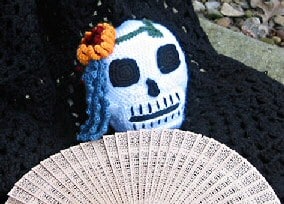
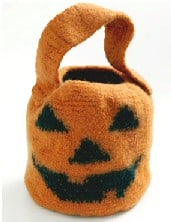
Crochet Mask
Here is a ‘Sweet Satisfaction’ crochet pattern which is a skein-and-notion-holder, inspired by the sugar skulls traditionally served for El Dìa de los Muertos.
Pumpkin Fashion Bag
45 free Halloween patterns that you can knit or crochet such as this crochet pumpkin candy bag and the knit skull candy bag. See more Halloween jokes on Pumpkin fashion.
Witch Doll
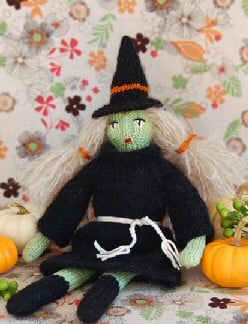
Mermaid Costume for Halloween
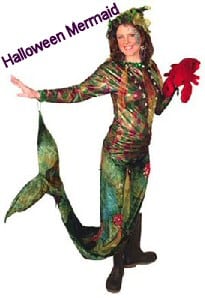

This year the top choices for Halloween costumes are Mermaids and Indian Jones. This surprised Will and Guy as we prefer the more traditional ghost-sheet. Looking at these pictures proves why we included these among our Halloween jokes.
Most Creative Costume:
Mondex, a Chihuahua, wears a pirate costume during a Halloween dog show for the benefit of an animal welfare organization in Manila, the capital of the Philippines. Mondex won the prize for the most creative costume.
Halloween – The Name Behind the Funny Pictures
Pretty much everyone agrees with the position of Halloween in the calendar, namely All Hallows Eve, October 31st. Funny Halloween jokes on pictures and images fall into three major categories.
- Symbols of death: ghosts, skeletons, haunted houses and graveyards.
- Symbols of evil: witches, goblins, and black cats.
- Symbols of harvest: pumpkins, Jack-o-Lanterns, scarecrows, and corn dollies.
Other variations of Halloween jokes about its name include:
- Hallow E’en – Ireland.
- Hallowtide or Hallowe’en – Scotland.
- Nos Galen-gaeof – Wales (The Night of the Winter Calends).
- Feralia – Roman.
- Samhain – Celts.
- The Feast of All Soula, also Feast of the Sun.
Halloween Myths
After discussing Halloween jokes, let’s take a pause and focus on common myths instead of Halloween jokes:
Halloween is the third biggest holiday for retail sales
While Americans spend an average of $75 on Halloween, they spend more on merchandise for Christmas, Mother’s Day, Valentine’s Day, and Easter. I find it hard to believe, but even Father’s Day sales outstrip those of Halloween.
Psychic Predicts Campus Murders at Halloween
This an interesting phenomenon because it repeats every 3 years. The gist of the myth is that a psychic on a radio or obscure T.V. show predicts that a madman is going to murder students and Halloween. There is no truth in this myth which started in 1968, it’s neat because after 3 years each campus will have a new batch of students who have never heard of the hoax.
A suicide was mistaken as a Halloween decoration.
The incident occurred just before Halloween in 2005 in Frederica Delaware. Unfortunately, this is a true story. Indeed it illustrates the problem with dismissing all hoaxes and myths because about 25% turn out to be true.
Funny Halloween Jokes & Animations
Here are some more Halloween jokes and animations.

The date is the last day of October. The sun set 5 hours ago, and Halloween approaches. Imagine you are walking past a churchyard. You suspect that the graves are haunted.





A Coven of Witches (Wicce)
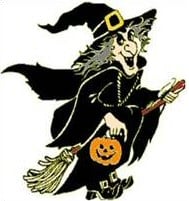
Did you know that a coven of witches means a gathering of 13 witches? Unfortunately, for some of us, a coven of witches can gather not just a Halloween, but at any time of the year. Sister, mother, aunty …. hmm that’s a lot of witch power.
English has many nouns which apply to either gender, for example, child, spy, or even angel. Originally witch was one of these neutral words, but increasingly, witch is a female preserve, and the equivalent male word became warlock.
There are other older words for witch, and they do have gender-specific endings, wicca (male) and wicce (female). Curiously, the plural of wicca and wicce is wiccan.
The oldest pre-Christian meaning for wicce and wicca includes fortune-teller as well as the creator of sorcery, medicine, and black magic. As with many ancient cults, most of the Wiccan secrets were passed on by word of mouth. Then just when information started to be written down, witches were hunted down and killed, thus not much incentive for them to write things down. Indeed, the ‘t’ first appears in the word wiTch about witch hunts in the 16th century.
Other Anglo-Saxon documents have the spelling as ‘Wica’. Many Saxon tribes had a ‘wise man’ or ‘wise woman’, who were consulted for potions to cure illnesses. It was a natural development of human nature to produce magic potions, which may (or may not) act as love charms, or spells to satisfy peoples’ desires.
These stories related to witches are integral to Halloween jokes.
Films Featuring a Coven of Witches
Speaking of Halloween jokes on witches, let’s take a look at movies featuring withches:
- Practical Magic (1998) With Sandra Bullock and Nicole Kidman are the witches.
- Deadtime Stories (1986) A traveler falls victim to a coven of witches.
- Crowhaven Farm (1970) Maggie and Ben move into the farm to try to save their troubled marriage. They soon see why the farm has a reputation for being haunted by spirits, and why it may be the home of an ancient coven of witches.
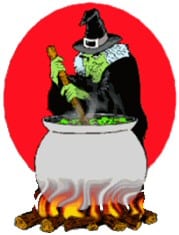
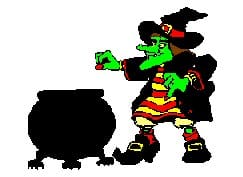

Funny Halloween Costume
We couldn’t miss this costume from our Halloween jokes.
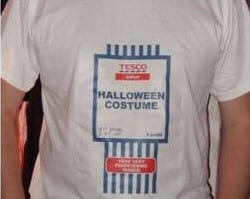
Funny Halloween Jokes & Cartoons
Will and Guy have started a collection of amusing Halloween jokes on images.
Halloween Turkey’s Revenge at Thanksgiving
Let’s start with Halloween jokes related to Thanksgiving.
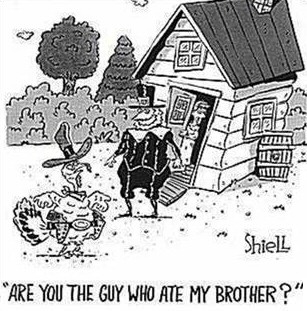
Black Sheet!
This one is indeed one fo the best Halloween jokes.
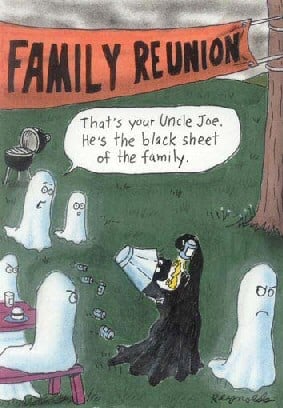
Witch Parking – Halloween Cartoon
More Halloween jokes on witches.
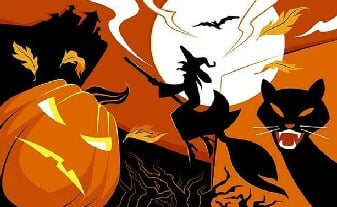
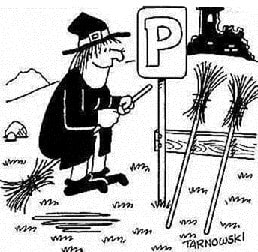
Jack PumpkinHead
Jack PumpkinHead is one of the most common characters of Halloween jokes.
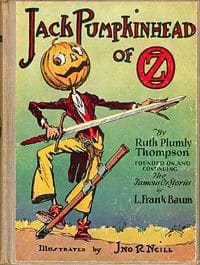
Funny Halloween Jokes on Cat Pictures
Cats, particularly black cats are symbols of evil, thus they come into their own on Samhain (All Hallows Eve). That’s why Halloween jokes often feature them.
Pumpkin Scares Cat at Halloween
On some Halloween jokes, pumpkin scare even cats.
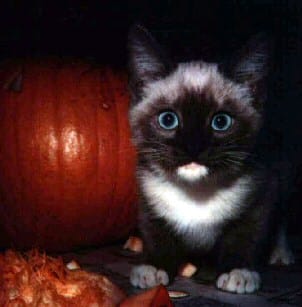
- The cat picture was kindly sent in by Bill Kuffrey
Another Cat Takes Revenge on the Pumpkin
Sometimes cats take revenge on pumpkins and these occasions become Halloween jokes.
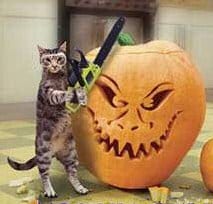
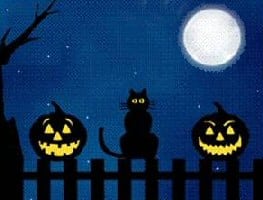
A Happy Ending
Happy endings are also part of Halloween jokes.
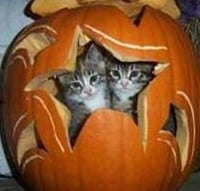
- When is it bad luck to meet a black cat at Halloween?
- When you’re a mouse!
A Witch’s Familiar – Her Cat
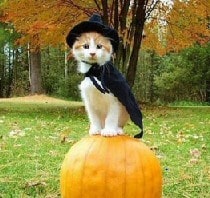
Halloween jokes about witches aren’t over yet.
Explaining a witch’s ‘Familiar’ is a complex topic. It can mean an assistant, who could help the witch by keeping a lookout and giving warnings of interlopers. A familiar can also mean an alter ego that a witch could change into and thus move around undetected. In both of these roles, you could think of familiars as evil spirits.
However, cats, particularly black Halloween cats, are the most common form of a witch’s familiar. However, they could be other animals such as toads, owls, or even mice. The uglier the beast the more suitable is to be a familiar.
Sinister Halloween Cat
Of course, our many of our Halloween jokes feature cats.
When black cats prowl and pumpkins gleam, May luck be yours on Halloween.
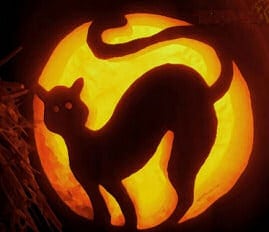

Pumpkin cat silhouetted against the full moon
To appease the spirits of the dead Druids organized a festival on the night before Halloween. While the celebrations varied from country to country, most festivities had bonfires and animal sacrifices. Although they did not have the elaborate Halloween costumes of today, no doubt our some of ancestors loved dressing up as much as some people do today.
Happy Halloween Cat Pictures
Now, we’ll just focus on some pictures as a part of our Halloween jokes.
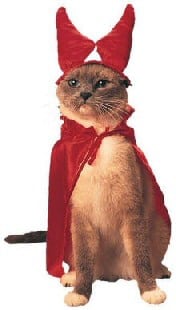
Russian Halloween Cats
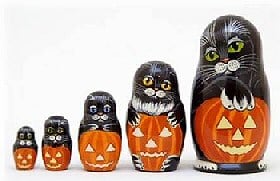
Unhappy Cat?
Of course, Halloween jokes wouldn’t be complete without unhappy cats.

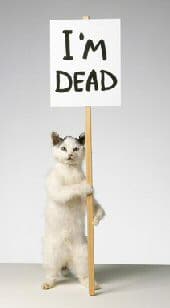
The King of the Cats – A Halloween Story by Ernest Rhys Fairy-Gold
Once upon a time, two brothers lived in a lonely house in a remote part of Scotland. An old woman used to do the cooking, and
there was no one else, unless we count her cat and their dogs, within miles of them.
One October afternoon the elder of the two, whom we will call Andrew, said he would not go out – so the younger one, Fergus, went alone to follow the path where they had been shooting the day before, far across the mountains.
He meant to return home before the early sunset – however, he did not do so, and Andrew became very uneasy as he watched and waited in vain till long after their usual suppertime.
At last, Fergus returned, wet and exhausted, but he did not explain why he was so late.
After supper when the two brothers were seated before the fire, on which the peat crackled cheerfully, the dogs were lying at their feet, and the old woman’s black cat sitting gravely with half-shut eyes on the hearth between them, Fergus recovered himself and began to tell his adventures.
‘You must be wondering,’ said he, ‘what made me so late. I have had a very, very strange adventure today. I hardly know what to say about it. I went, as I told you I should, along yesterday’s track. A mountain fog came on just as I was about to turn homewards, and I completely lost my way. I wandered about for a long time not knowing where I was, till at last I saw a light and made for it, hoping to get help. As I came near, it disappeared, and I found myself close to an old oak tree. I climbed into the branches the better to look for the light, and, behold there it was right beneath me, inside the hollow trunk of the tree. I seemed to be looking down into a church, where a funeral was taking place. I heard singing and saw a coffin surrounded by torches, all carried by, But I know you won’t believe me, Andrew, if I tell you.’
His brother eagerly begged him to go on and threw a dry peat on the fire to encourage him. The dogs were sleeping quietly, but the cat was sitting up and seemed to be listening just as carefully and cannily as Andrew himself. Both brothers, indeed, turned their eyes on the cat as Fergus took up his story.
‘Yes,’ he continued, ‘it is as true as I sit here. The coffin and the torches were both carried by cats and upon the coffin was marked a crown
and a scepter.’
He got no farther, for the black cat started up, shrieking, ‘My stars. Old Peter’s dead, and I’m the King of the Cats.’
He then rushed up the chimney and was never seen again.
Funny Halloween Drinks
Halloween drinks are also a big part of our Halloween jokes. Everyone has their favorite tipple at Samhain, see our pumpkin beer, witches brew, and Dracula’s cocktail.
Pumpkin Beer for Halloween
We have come across a pumpkin beer which sounds just the job for a Halloween celebration. This is a seasonal Harvest Time Pumpkin Ale, brewed by ‘Big Boss’.
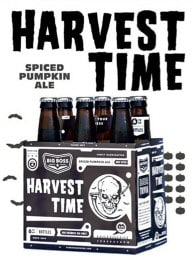
Will and Guy can reveal that the quote on the beer reads: “Harvest Time Pumpkin Ale is a subtly-spiced, fall ale brewed with a real pumpkin that will evoke memories of holidays and family.”
Although some brewers only use pumpkin spice in their pumpkin ale, Big Boss uses real pumpkin as well as a blend of spices. Though they have not revealed their blend of spices to us, we think it is likely something with some form of cinnamon, nutmeg, or allspice.
Guy Drank ‘One Over the Eight’ Pumpkin Ales?
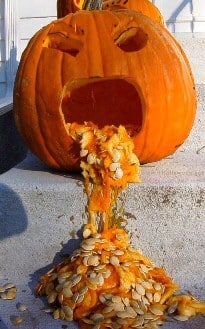
For the morning after, why not try one of Harry Cradock’s cocktails? We can recommend his ‘Corpse Revivers’.
Funny Drinks at Halloween – Witches Brew
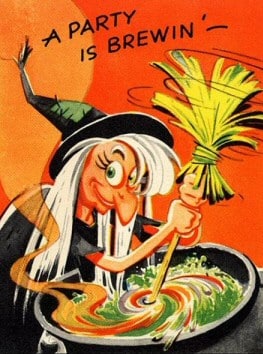
Witches make wicked brews, especially at Halloween. Think of Shakespeare’s Macbeth.
Round about the caldron go;
In the poison’d entrails throw.
Toad, that under the cold stone,
Days and nights hast thirty-one
Swelter’d venom sleeping got,
Boil thou first i’ the charmed pot!
Double, double toil and trouble;
Fire burn and caldron bubble.
But Remember: NO Drinking and Flying After a Witches Brew
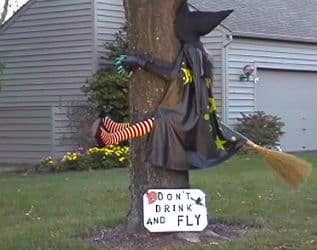
Halloween Chandelier
Schnapps is the official spirit of Halloween, by decree of Samhain.

- An elevator makes ghosts happy because it lifts their spirits.
Pub Names Can Provide Protection at Halloween
Masons building a church in the Middle Ages, says Will, would have stayed probably at a local inn and many pubs took ecclesiastical names upon
completion of the place of worship.
The ones rebuilding St Bride’s church after the Great Fire of London [1666] stayed, for example, in the Old Bell in Fleet Street. Bells were believed to have magical powers, protecting against evil spirits and lightning.
Get In The Spirit Of All Hallows With Spooks Ale

Ghostly Guest Beer in UK Pub
Ale drinkers in the Duke of Buckingham, Old Portsmouth, UK are being challenged to try something spooky this Halloween – if they dare.
The eerily tasty Spooks Ale from Shepherd Neame will be available in bottles and casks from mid-October. The Official Ghost Brew of All Hallows, Spooks Ale offers a rich and spicy taste, with a fruity and biscuity aroma. According to the blood-spattered, parchment-like label, the 4.7% abv beer contains “Gall of Shepherd, Slip of Neame, Silver’d in the Kent’s Moon Dream.”
Shepherd Neame is used to ghostly goings-on, as one might expect from Britain’s oldest brewer. Spectral sightings at the historic Faversham brewery have included a feline phantom walking through reception and a ghostly group of monks haunting an old malt kiln.
Before today’s urban noise, bells ringing out to summon the faithful to prayer or sounding curfew would have been far more noticeable. No wonder names like Bell, Old Bell, Six
Bells and Eight Bells are so often seen.
The Bucket of Blood
There is also a pub called the Bucket of Blood in Cornwall. Now the only pub in England with the name, the Bucket of Blood refers to an episode
some 200 years ago when the landlord went outside to draw water from the well. Pulling up the pail, he found the water to be bright red, as a corpse had been thrown down the shaft.
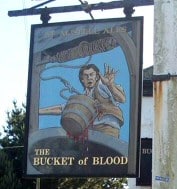
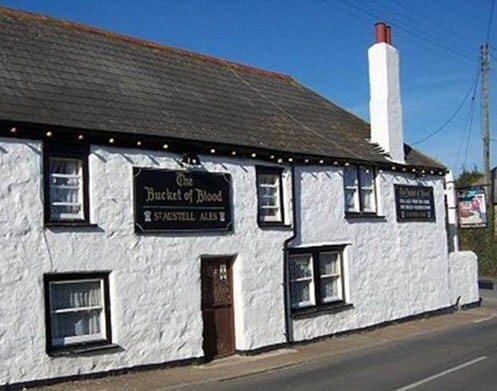
It is claimed to have been a revenue officer who was investigating smuggling activity, though the truth will never be known. The famous incident is featured on the pub sign, which creaks menacingly on its pole beside the small, whitewashed cottage. The pub looks much the same as it has for centuries; inside, the bar room is low-ceilinged and is cozy.
Now there’s a pub to have a drink at Halloween say Will and Guy.
The Bell Inn
One room at this pub at Castle Hedingham, Halstead, Essex, UK, is said to be haunted by a young girl with black hair who has been known to suddenly whip the bedclothes from people staying in her room.
There could also be the ghost of an old man who knocks on the bedroom doors.
The Bell Inn has a 300-year-old history.
The Leaky Cauldron and Harry Potter
The Leaky Cauldron is a pub and inn for wizards, located on the Muggle Street of Charing Cross Road in London, offering food, drinks, and rooms to rent. It was founded by Daisy Dodderidge (1467-1555) in 1500 “to serve as a gateway between the non-wizarding world and Diagon Alley.” The current barman and innkeeper is a wizard named Tom. On the main floor, the inn has a bar, several private parlor rooms, and a large dining room. On the upper floors, there are several rooms available; Harry has stayed in Room 11 which has a talking mirror and windows that allow him to look out onto Charing Cross Road. People often stay at The Leaky Cauldron when they come up to London on shopping trips.
The pub serves as a way of entering into Diagon Alley from the Muggle world for Muggle-borns and their parents (both of whom, until the first letter from Hogwarts, have no magical knowledge or means of entering). The rear of The Leaky Cauldron opens onto a chilly little courtyard where a brick (found by counting three up and two across) is tapped three times.
JJK Rowling has revealed that Hannah Abbott becomes the landlady of the Leaky Cauldron, and lives above the pub with her husband Neville Longbottom, when he is not teaching Herbology at Hogwarts.
Halloween Cocktails to Wet Your Palate
The Dracula Cocktail
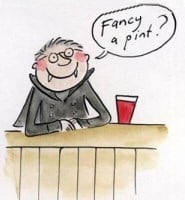
Will and Guy have selected this cocktail from an old ‘Bar Guide’ found on our office bookshelves. It is not recommended for minors but only for adult ghouls and ghosties; witches and warlocks.
Will, of course, is a warlock as he was born on Halloween.
- 2 oz white rum
- ½ tsp grenadine
- 1 oz lemon juice
- 4 oz cranberry cocktail
- A couple of dashes of Angostura bitters
- Shake well with ice, and pour into a tall glass.
- Add more ice if necessary.
Will and Guy’s Halloween Punch
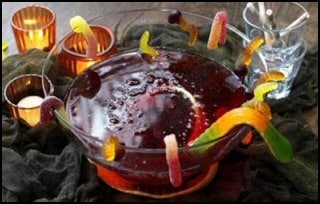
This blood-red punch is perfect for a Halloween party. We suggest that for an adults’ version add some gin or vodka.
Ingredients
- 500ml/18fl oz cranberry juice
- 1.5 litres/2½ pints lemonade
- 3 limes, juice only
- A large handful of gummy worms
Preparation method
- Pour all of the ingredients into a large glass bowl and mix until well combined.
- Drape the gummy worms.
More Funny Drinks at Halloween
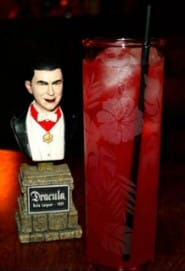
Goblin Ghoulade
This is so easy to make and we like especially the tart cranberry juice and sweet black raspberry liqueur can make any cocktail look like blood. For some added effect, an “eyeball” made of radish and blueberry is added on top, warning visitors of what can happen to them if they leave your party early.
Ingredients
- 1 oz. Vodka
- 1 oz. Black raspberry liqueur. The French make liqueurs using ‘mure’, blackberry which we favor.
- 1 oz. Lime juice
- 1 oz.
- Cranberry juice
- 1 Radish
- 1 Blueberry
- Preparation:
- Pour all ingredients into a cocktail shaker and shake. Strain the drink into a martini glass. To create the eyeballs, peel 1 radish per glass and leave some red skin to form veins. Hollow out the center of radish and place a small blueberry to form the eye. Serve eyeball floating or on a drink skewer.
A Blue Satan
Guy thinks this is possibly the simplest cocktail of all to make:
- 1 ½ oz gin
- ½ oz blue curacao
- 1 oz lemon juice
- Add tonic or soda to taste
- Shake with ice and serve chilled and up in a cocktail glass.
- Garnish with a floating lemon or orange slice.
Funny Halloween Games for Kids
- Why wasn’t there any food left after the monster party?
- Cos everyone was a goblin
How To Enjoy a Family Halloween
Will and Guy offer these suggestions for a fun-filled family celebration. These Halloween ideas are based on making your own fun and not relying on purchases from a supermarket. These Halloween games for kids are based on an article written by Eleanor Bailey in The Guardian newspaper (UK).
1. Ugly Monster Beauty Contest
The adults allow their faces to be “face painted” by the children. The uglier the better and then parade for the children to select the best. Old clothing could also be utilized as dressing-up materials. Prizes could be on offer.
2. Telling Halloween Horror Stories in the Round
This is regularly a vote winner with children above the age of 5 years. Sit the family in a circle in the dark. Have some starter sentences previously
prepared in a witches hat in the center, like: “A headless man entered the room…………..” or “The wind howled and there was a knock at the door………………”. In turn, each player picks out a sentence and shining a torch in their own face begins the story and then passes the torch on. Listen to the howls of laughter as the story becomes more and more gruesome.
3. Ghoulish Laugh Competition
Everyone in turn has to perform a hideous and maniacal laugh. Movement and facial expressions are important as well.
4. Unlucky Dip in a Bucket of Ghoulish Horror
Place various items in a bucket. [A peeled grape could be Nelson’s eye; a tin opener could be a medieval torture instrument; a carrot might be a witch’s finger, fruit pieces are useful here]. Encourage imagination and in turn, allow the family to remove an object and invent or refer to a ghoulish story or an episode from history.
5. Food and Drink
Make a “horror brew”. Using an old bucket encourages the family to place in it all manner of horrific items; plastic spiders, stones, spit, old tea bags, cabbage leaves[bats’ wings], and old tights ripped [witches skin]. You, then go into the kitchen and close the door. Make horrible noises, wailing, and turn on the blender to make them think you are mixing an evil brew. Emerge maniacally with the witch’s brew: some form of juice with green dye previously hidden in the fridge.
Food may include cakes [see below]. Also, young children could make sugar mice or spiced apple cake. Make a creamy pumpkin soup from the innards of your lantern.
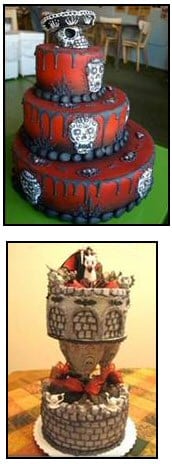
Funny Halloween Cakes
Will and Guy ask, ‘Why not bake a cake this Halloween? Better still, make sure the kids have fun this Halloween and get them to bake it.
Here are some classic examples to fire your imagination and for you to develop your own Halloween ideas. You could show older kids how to decorate the cakes, and then leave the rest to their imagination and creative skills.
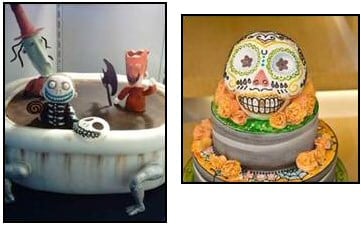
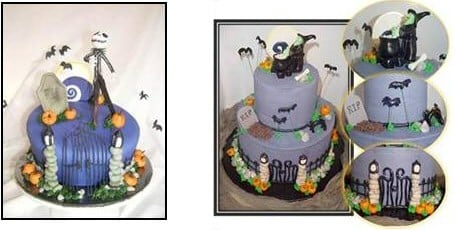
Halloween Cake Goes Wrong
When a cake turns out ‘wrong’, it can be ‘well bad’, which means just right for a Halloween party!
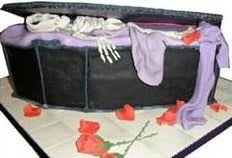
Fun Halloween Game for Kids – Bobbing for Apples
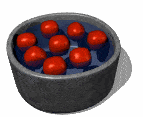
In my youth the main event at Halloween was not trick and treating, but bobbing for apples. What we did was try to catch one of the apples in a bowl of water using only our teeth.
Our cousins played a variation whereby Aunty hung the apples from strings so that they swung about and refused to be caught. In both adaptations, the player’s hands were tied behind their back.
You would think that apple bobbing was a game made for big mouths, yet I recollect that the best player was always the quiet little girl who managed to nip the stalk and then wrestle the apple from its string, or out of the water.
Bobbing for apples probably has multiple origins. The timing is such that apples are abundant after the harvest, thus allowing experimenting with apple games at Halloween. In the Middle Ages, witches were tortured on ducking stools, hence children could mimic this gruesome ceremony using apples as witches. Witches often suffered a version of ‘Morton’s fork’. When they were tied to the ducking stool and then held under the water, if they died of drowning, they were pronounced innocent. Yet if they survived, then they must be guilty of witchcraft and were promptly burnt at the stake.
Some believe that bobbing for apples may be linked to an older Roman worship of Pomona the goddess of orchards.
Apple bobbing – by Carolyn Wells
You wouldn’t believe
On All Hallow’s Eve
What lots of fun we can make,
With apples to bob,
And nuts on the hob,
And a ring-and-thimble cake.

Halloween Bike Ride

Think of the fun and game you could have on this bike.
Halloween Story for the Fireside
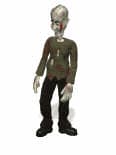
Bad Segeberg, Hamburg – Germany
Passengers on a train thought that a Halloween reveler, who was dressed up as a zombie, was a murder victim. They were alarmed because his hands and face were smeared with what looked like blood. Because they suspected foul play, fellow passengers on the train called the police and also alerted the ambulance service.
When paramedics arrived they soon realized that the 24-year-old man was in a drunken slumber rather than dead. A little later the police boarded the train, questioned the man, and asked him to remove his frightening make-up. He was then allowed to continue his train journey home.
An official police spokeswoman said:
‘Bad Segeberg is in a rural area and Halloween isn’t very well known there; so people weren’t expecting anyone to be dressed up in the train.’
An un-attributed acquaintance said:
‘I was on that train, and my friend looked just the same as normal. I don’t understand why they called the police.
Funny Halloween pictures
Will and Guy have deliberately collected photos, cartoons, and pictures to illustrate a wide variety of Halloween themes.
- Why don’t angry witches ride their brooms?
- They’re afraid of flying off the handle!
Este dìa de las brujas no tomes y manejes
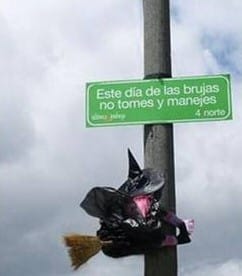
Our resident Spanish expert, Bertie, says it should say: Este dìa de las brujas no beba y vuele. However, Will and Guy would appreciate clarification from a true Spanish expert. Does ‘Este dìa de las brujas no tomes y manejes’ really mean, ‘The day of the witches, do not take the
handle’, or has Bertie himself had too much Vinho collapso?
Halloween Safe Zone – Witches Cannot Pass
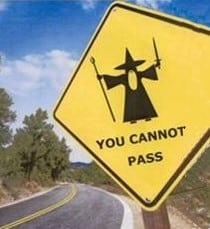

Funny Halloween Pictures Featuring Animals
Why Dogs HATE Halloween


- What is Dracula’s favorite dog?
- A bloodhound!
More of Will and Guy’s Collection of Funny Halloween Pictures
We are always on the lookout for amusing pictures of witches, ghosts, and pumpkins. In truth, the funniest part of Halloween is the doing, and
the telling of derring-do tales afterward. Meanwhile, here are funny Halloween pictures to put you in the mood for a little trick-or-treating.
Recession Hits Haunted Houses
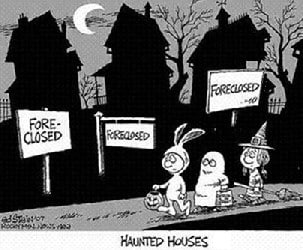
A Motley Collection of Halloween Characters
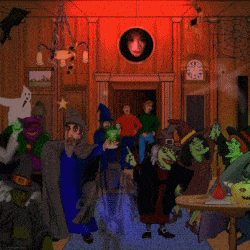
After each grown-up Halloween party, watch out for a new round of stories involving a husband swapping his fancy-dress costume with another guest, followed by the wife then kissing the ‘wrong’ man.
May Have Eaten a Ghoulish Egg?
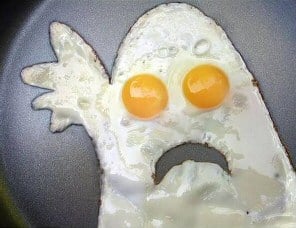
More Funny Halloween Jokes
- Why did the vampire’s lunch give him heartburn?
- It was a stake sandwich.
- What would you call the ghost of a door-to-door salesman?
- A dead ringer.
- What do skeletons always order at a restaurant?
- Spare ribs!
- Who won the skeleton beauty contest?
- No body
Trip to ASDA
It was the end of October and I was waiting for my wife, Diane, at the checkout of the ASDA supermarket in Golders Green, London, England, and I spotted that someone had left their broom at the till.
When no one came to claim it, I went outside to search for a couple I remembered seeing at the cashier’s desk. I spotted them getting into their car and shuffled over.
Pardon me,’ I said to the young woman, ‘but did you by any chance leave your broom inside?’ ‘No,’ she replied quickly and with a smile, ‘we came by car.’

Funny Halloween Quotes
- Ghosts, like ladies, never speak till spoken to. – Richard H. Barham
- At first cock-crow the ghosts must go Back to their quiet graves below. –Theodosia Garrison
- If a man harbors any sort of fear, it makes him landlord to a ghost. – Lloyd Douglas
- If you haven’t found something strange during the day, it hasn’t been much of a day. – John A. Wheeler
- We live in a Newtonian world of Einsteinian physics ruled by Frankenstein’s logic. – David Russell
- Those who believe in telekinetics, raise my hand. – Kurt Vonnegut
Funny Halloween Postage Stamps

When researching various aspects of Halloween Will and Guy were very surprised when we came across the fact that in Europe, both Belgium and France have Halloween postage stamps. While the USA has not been left behind when it comes to funny Halloween postage stamps.
French Halloween Postage Stamp
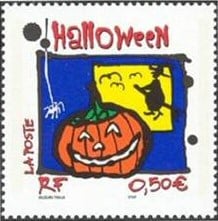
We wonder if this pumpkin has been drinking too much of the new season’s Beaujolais Nouveau. He really should have waited until the third Thursday of November rather than quaffing this season’s wine at Halloween.
American Halloween Postage Stamps
In the USA, a private company has created both ‘Gothic-style and ‘Halloween-style’ stamps that can be used officially when sent through the
US Mail system. Here are four examples of ‘Gothic’ Halloween postage stamps:
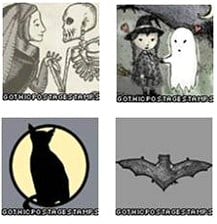
Examples of American Halloween Postage Stamps

As we research these funny Halloween postage stamps, we cannot help reflecting on stamp collecting from our childhood. We conclude that the secret of successful stamp collection is ‘swapsies’ and the internet provides a rich source of people willing to exchange stamps.
Belgian Halloween Postage Stamps
This example shows three things associated with the celebration of Halloween: a particularly splendid-looking witch, a black cat, and flying bats. These stamps were first put on sale in Belgium in 2004.
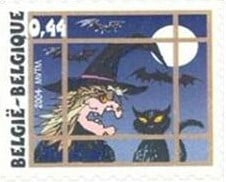
This second Belgian stamp has flying bats at the top and the famous Jack O’Lantern in the middle

Halloween Postage Stamps
Of all the special events in the year, you could think of Halloween as the naughty boy, or rather, the naughty girl of days. The fact that so many countries now have commemorative stamps for Halloween, further legitimates this day as having, or regaining, its special place in the calendar. We like these stamps because they are funny and frivolous, when we see them on an envelope it reminds us of the season ahead.
Stamp Collections
The English royal family has one of the oldest stamp collections in the world. Queen Victoria’s second son ‘Affie’, began the collection back in the 19th century. Later King George V added to the royal stamp collection, and today Queen Elizabeth is a keen philatelist. One of the strengths of the royal collection lies in its completeness, another feature is the accompanying drawings and proofs of commonwealth stamps.
Funny Halloween Sayings
- Where there is no imagination there is no horror. – Sir Arthur Conan Doyle
5 Halloween Sayings
- Tis now the very witching time of night,
When churchyards yawn and hell itself breathes out Contagion to this world. – William Shakespeare - Shadows of a thousand years rise again unseen, Voices whisper in the trees, ‘Tonight is Halloween!’ – Dexter Kozen
- There are three things I have learned never to discuss with people: religion, politics, and the Great Pumpkin.- Linus from “It’s the Great Pumpkin, Charlie Brown.”
- This Halloween the most popular mask is the Arnold Schwarzenegger mask. And the best part? With a mouth full of candy you will sound
just like him. – Conan O’Brien. - From ghoulies and ghosties
And long-leggedy beasties
And things that go bump in the night, Good Lord, deliver us! – Scottish Saying.
Will and
Guy Bring You 10 Fun Halloween Quotations
- The witches fly
Across the sky,
The owls go, ‘Who? Who?Who?’
The black cats’ yowl
And green ghosts howl,
‘Scary Halloween to you.’ – Nina Willis Walter. - ”Tis now the very witching time of night,
When churchyards yawn and hell itself breathes out Contagion to this world.’ – William Shakespeare - If a man harbors any sort of fear, it makes him landlord to a ghost.- Lloyd Douglas
- ‘From ghoulies and ghosties and long leggety beasties and things that go bump in the night, Good Lord, deliver us!’ – Scottish Proverb.
- ‘Eye of newt, and toe of frog, Wool of bat, and tongue of dog,
Adder’s fork, and blind-worm’s sting, Lizard’s leg, and owlet’s wing,
For a charm of powerful trouble, Like a hell-broth boil and bubble.’ – William Shakespeare. - There is nothing funny about Halloween. This sarcastic festival reflects, rather, an infernal demand for revenge by children on the adult world. – Jean Baudrillard
- Pixie, kobold, elf, and sprite,
All are on their rounds tonight;
In the wan moon’s silver ray,
Thrives their helter-skelter play. – Joel Benton - ‘You wouldn’t believe
On All Hallow’s Eve
What lots of fun we can make,
With apples to bob,
And nuts on the hob,
And a ring-and-thimble cake.’ – Carolyn Wells - On Halloween, the parents sent their kids out looking like me. – Rodney Dangerfield
- ‘Tis the night – the night
Of the grave’s delight,
And the warlocks are at their play;
Ye think that without
The wild winds shout,
But no, it is they – it is they. – Arthur Cleveland Coxe
A Creepy Tale from a Vienna Graveyard
Chris Cross, a tourist in Vienna, is going passed Vienna’s Zentralfriedhof graveyard on October 31st. All of a sudden he hears some music. No one is around, so he starts searching for the source. Chris finally locates the origin and finds it is coming from a grave with a headstone that reads: Ludwig van Beethoven, 1770-1827. Then he realizes that the music is the Ninth Symphony and it is being played backward! Puzzled, he leaves the graveyard and persuades Tim Burr, a friend, to return with him.
By the time they arrive back at the grave, the music has changed. This time it is the Seventh Symphony, but like the previous piece, it is being played backward. Curious, the men agree to consult a music scholar. When they return with the expert, the Fifth Symphony is playing, again backward. The expert notices that the symphonies are being played in the reverse order in which they were composed, the 9th, then the 7th, then the 5th. By the next day, the word has spread and a throng has gathered around the grave. They are all listening to the Second Symphony being played backward.
Just then the graveyard’s caretaker ambles up to the group. Someone in the crowd asks him if he has an explanation for the music.
“Oh, it’s nothing to worry about,” says the caretaker. “He’s just decomposing!”
Halloween One-liners
- What did the mother ghost say to the baby ghost? Fasten your sheet belt.
- Doctor, doctor, I’m so ugly. What can I do about it? Hire yourself out for Halloween parties.
- What do fishermen say on Halloween?” Trick-or-trout!”
Silly Things People Say That Probably Annoy You and Me
- People who point at their wrists while asking for the time.
- People are willing to search the entire room for the TV remote because they refuse to get up and change the channel manually.
- People who say, ‘Oh you just want to have your cake and eat it too’. Yes! What good is cake if you can’t eat it?
- People who say, ‘It’s always the last place you look’. I tend to stop looking once I’ve found it.
- When people watching a film say, ‘Did you see that?’ What do they think I was watching?
- People who ask, ‘Can I ask you a question?’
- When something is “new and improved”. Which is it?
- When people say, ‘life is short’. Life is the longest thing anyone ever does. What can you do that’s longer?
- When you are waiting for the bus and someone asks, ‘Has the bus come yet?’. If the bus had come would I be standing there?
Witches and Halloween
What separates the Halloween witch from sister wicce is her broomstick. In pagan festivals, the broomstick is associated with cleansing and initiation rituals. It is easy to see how flying could enter the Halloween picture, because this is a time when the spirits were coming down to earth, and also the living were high from eating magic mushrooms and other hallucinogenic potions. And of course, her caldron was handy for witches to brew up spells to control those who offended her; take Shakespeare’s Macbeth and the three witches’ famous refrain: ‘Double, double toil and trouble; Fire burn, and caldron bubble’.
The Cost of Halloween

These raw numbers be-fuddle Will and Guy, however, we understand the big picture well enough. At Halloween people spend most on candy and
sweets, followed by costumes. We were surprised that the amount spent on decor has doubled. This is not due to a dramatic rise in the cost
of a pumpkin, more people are buying battery-powered accessories that scream or light up.
- Candy ($2.1 billion)
- Costumes ($1.6 billion)
- Halloween decor ($0.7 billion)
It shows what we know, at first we thought these figures were million when it turned out on close inspection they were in BILLIONS of dollars.
While Americans spend an average of $72 on Halloween, they spend more on merchandise for Christmas, Mother’s Day, Valentine’s Day, and Easter. I also find it hard to believe, that even sales for Father’s Day cards and gifts outstrip those of Halloween.
One theme that runs through Halloween, is pure fun and self-indulgence. You don’t have to buy presents for friends and relatives, you just buy ‘stuff’ for yourself.
Trick or Treat

There is no doubt that ‘Trick or Treat’ has very old roots dating back to the pagan customs surrounding Samhain. Related customs include wassailing and souling, indeed, in its original form the idea was that the recipients of barnbrack cakes would pray for the souls of the relatives who gave them the ‘treat’.
As with many customs Trick and Treat waxed and waned. During my childhood in the UK in the 1950s and 1960s, I don’t remember any organized ‘Trick and Treating’. What seems to have happened is that it has been re-introduced into the UK from America in the 1990s. These days parents are so paranoid about their children being out after dark and alone, that they now supervise their children’s Trick or Treat from the shadows of the nearest lamppost.
Catholic areas in general, and Ireland in particular, favor Trick and Treat, whereas Protestant heartlands celebrate the gunpowder plot on November 5th. My point is that this season, Halloween/November 5th is a great time for celebrations based around bonfires and fireworks. And ‘Trick or Treat’ is a great ruse to stock up on food ready for the cold night’s festivities. See more on Halloween trick or treat.
See more Halloween stamps
Dates of the Four Fire Festivals
1st Nov Samhain – Nos Galen-Gaeaf in Welsh
In ancient times the celebration of any festival started the night before, hence Halloween is the evening of 31st October.
2nd Feb Candlemas – Oimelc in Irish. Celebration of Spring / 40 days since the nativity.
1st May Beltane – May Day
1st Aug LammasLughnasadh in Gaelic, celebrates the start of the harvest
Halloween trick or treat? night
Trick or treat, you’re so neat.
Give us something good to eat.
Nuts and candy, fruit, and gum.
We’ll go away if you give me some.
7 Signs That You Are Too Old For Trick or Treat
- You have to choose a costume that won’t dislodge your hairpiece.
- Children say, ‘Great Mick Jagger mask!’ But you’re not wearing a mask.
- You get out of breath climbing three steps and knocking at the door
- You ask for high-fiber candy.
- You lose your false teeth apple bobbing.
- You are the only ‘ghost’ with a Zimmer walker frame.
- At the end of the evening, you have more restraining orders than treats.
Origins of Trick or Treat Superstition
Remember that the main focus of Halloween is communication with the spirits of one’s ancestors. Let us set aside the form of the spirit, and focus on the act of connecting with departed souls.
It is only human nature that some individuals will take these spirits very seriously, whilst others will seek to take advantage of the desire to contact the ancestors. I put it to you that amongst the ancients, that advantage could be a simple proposition; a promise to pray for the souls of someone else’s departed in return for a small favor, a ‘soul cake’, or a bowl of soup.
Now it only takes a small step to create a ritual that becomes, trick or treat. ‘Give me a bowl of soup, and I will pray for the souls of your departed – or else I will curse you’. If you have plenty of soup or soul cakes why take the chance? As for the chances, they know who has the cakes and the greatest fear of a curse.
For the trick-or-treaters, it’s a win-win situation, they either get some food or have fun playing a prank. Down the ages, and across the continents, the rituals surrounding trick and treat vary enormously as we will see in the following tales.
A Trick or Treat Ditty:
Trick or treat, smell my feet.
Give me something good to eat.
If you don’t, I won’t be sad.
I’ll just make you wish you had!
Guising Superstition
Scotland and Ireland are the originators of Guising. Incidentally, disguising and guising are a pair of words that have the same meaning, yet seem logical opposites; perhaps flammable and inflammable are the most famous examples of this lexical phenomenon.
Over time ‘Trick or Treating’ has taken on many local variations. For example in Scotland from about 1850 to 1965, the guisers would patrol not with a pumpkin lantern, but a tumshie lamp made of swede or turnip.
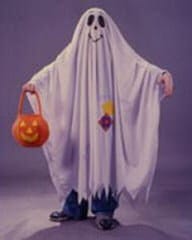
In this Scottish variation, the children would knock at the door and ask: ‘Are ye wantin’ any guisers?’. If the householders wanted to play the game, they would invite in the children and try and guess the identities of the guisers. Still no treat. To get food or a coin, the children had to perform their party piece, which could be a song, dance, or even a magic trick. Only then would they get a well-earned treat.
In Ireland, they also go in for guising, but the emphasis is more on pranks, and not just on Halloween, but in the week leading up to October 31st. The Irish have always been particularly keen on bonfires on Halloween, whereas the English protestants prefer to wait a few days and celebrate Bonfire night on November 5th.
In Germany and Austria they celebrate Seleenwoche, this festival lasts from October 30th to November 8th. The theme revolves around leaving out bread and drink for the spirits of ancestors returning for the night of Halloween.
Old Timer’s Trick or Treat – Halloween Pranks
On Halloween 1906 four boys took apart a shop owner’s wagon and put it back together, but on his porch. What they did not know was that he watched quietly from his bedroom window and so the owner knew all the boys.
After they got done, he calmly said, “Boys, I’m glad you had some fun, but if that wagon is back on the street in the morning, there will be ice
cream for everyone.”
‘Penny for the Guy’
On Bonfire night (5th of November), the emphasis is on extracting money rather than sweets from passers-by. The trick is to get a good pitch
for your ‘Guy Fawkes’. Time spent in getting a good costume and a realistic hat is rewarded by greater takings.
Trick or Treat Prank Misfires
It was meant as a Halloween prank, however, Police were far from impressed with this Trick-or-treat.
Police say three teenagers weren’t at all clever about choosing a target. The youngsters, a 17-year-old and two 15-year-olds peppered a marked police car with paintballs – and were promptly arrested on reckless endangerment and weapons charges.
Suffolk County police say the teens fired at their police car with several paintballs on 31st October 2007 in Middle Island, on Long Island, New York. The driver’s side window was hit at least twice. Police reported that the youths were carrying three paintball guns and ‘several hundred’ paintballs when they were arrested.
Trick or Treat Halloween Jokes
- What did the gamekeeper say to the fishermen at Halloween?
‘Trick-or-trout!’ - What did the budgie say at Halloween? ‘Trick-or-tweet!’
- Where did Mother say was the most dangerous place to go trick-or-treating? On psycho’s path!
Trick or Treat Halloween Poisonings
Every generation has its horror story of a madman giving poisoned candy to unsuspecting trick-or-treat kids. Fortunately, they all turn out to
be hoaxes. Perhaps it’s a way of telling children to be careful. Will and Guy look for TV or newspaper articles that claim to have unearthed the latest ‘A madman is distributing candy randomly to trick or treaters’.
Clark O’Brien Case
There was a case of a child being poisoned by a candy bar at Halloween, however, in that instance, it was his father. In 1995 Ronald Clark
O’Brien was convicted of poisoning his son Timothy with cyanide in a Pixie Stix. One fortunate aspect of this case was that O’Brien DID give
the poisoned candy randomly to three other children. As luck would have it those children did not like Pixie Stix, so they did not eat the
cyanide and survived.
Darren Brown Trick or Treat TV Programme
Derren Brown is an English magician and illusionist who performs a Mind Control series on Channel 4 in the UK. Derren was inspired by the
hypnotist Martin Taylor to take up a career in illusion and hypnosis.
One interesting experiment was all the volunteers who had previously received a trick or treat in previous episodes. This programme highlighted
the belief of superstition, and how it can be applied in the real world.
No Trick, No Treat in Moscow – Schools Ban Halloween

The Russian Orthodox Church and the Moscow city school administration are taking a stand against Halloween. The educators say that bringing elements of religion into the classroom is inappropriate, while the clerics condemn its connection with evil spirits.
The Moscow education administration has written to schools banning celebrations. ‘Religious elements in the celebrations contradict the secular part of the education in state educational institutions,’ the letter said, according to Russia’s NTV.
The department is also reportedly concerned that ghoulish elements of the holiday have upset parents. ‘Parents have expressed
their unhappiness that some schools are celebrating this – how do you call it? – event or holiday,’ a department spokesman told the Moscow Times.
The spokesman, Alexander Gavrilov, said parents were distressed to see children pretending to hang each other after Halloween.
A Russian Orthodox Church spokesman, meanwhile, said Halloween was ‘more than strange’. Halloween, the night before the Christian All Saints Day, and incorporating pre-Christian elements – is not widely celebrated in Russia.
Trick or Treat Night – Will and Guy’s View
Breaking every rule in the parent handbook happens on Halloween say Will and Guy.
We wonder if more care should be taken by parents on this particular evening. After all, we spend our lives, when the children are young, warning them to beware of strangers with sweets, and what happens?
Halloween: we encourage them to knock on the doors of strangers, make demands with menaces, and binge on sugary items.
Dressing up in a scary costume and cadging chocolate and money is an irresistible proposition for any child. Perhaps we should not be encouraging them? Is it harmless fun or an irritating excuse to annoy the neighbors? Will has observed that some neighbors, near his home, never close their curtains in their lounge except on Halloween.
The rest of the year we warn children about the dangers of strangers and then under the guise of trick or treating, encourage youngsters to dress in masks and approach strangers demanding money. There’s a tap on the door and standing in the streetlight, silhouetted by the neighbor’s security light, is a gaggle of young teenagers. One wears a broken plastic horror movie mask. Another has the script. ‘Trick or treat.’ That’s about the limit of the rich cultural fare on offer. They want money, they might put up with sweets. They’re certainly not giving anything back in exchange.
We wonder when trick or treating became such a fixture in the UK Calendar. We ask the question because trick or treat is not a tradition. Maybe it was in the 1980’s it was imported similar to the Japanese ‘knotweed’ and it has spread in the same way.
During the 1980s, the House of Lords debated the ‘recently imported trick-or-treat custom of demanding money on a threat of playing a nasty trick as being a way in which young people might obtain money from old people and others’. Their lordships saw trick or treating not as a tradition but as American for begging. We ought to be questioning the festival ourselves, in much the same way.
Will and Guy bemoan the fact that trick or treating is a consumer proposition. It’s a sales pitch, not a festival. Spook-related spending in the UK has risen tenfold in a decade, up to £120m. In the US, Halloween is worth $6bn a year to retailers.
We wonder if you agree?
Trick or Treat Times
Most American municipalities sensibly set times for trick and treat. I haven’t seen any ordinances that allow times later than 8:00 pm, and many
are in the range of 4-6.00 pm thus favoring younger children. We can only hope that this idea of limiting the Trick or Treat times will cross the
Atlantic, after all the UK is small enough to designate a national time.
Pumpkin Carving Design Ideas
The secret is to start with a healthy pumpkin. My Litmus test for a good pumpkin is a healthy stem and a firm bottom.
Scary Pumpkin Carvings

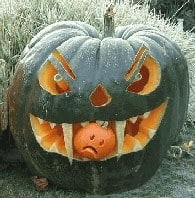
What a lot of work went into creating these frightening pumpkin lights.
Frankenstein Pumpkin Monster


May Jack-o-lanterns burning bright Of soft and golden hue Pierce through the future’s veil and show What fate now holds for you.
Famous Pumpkin Carvings
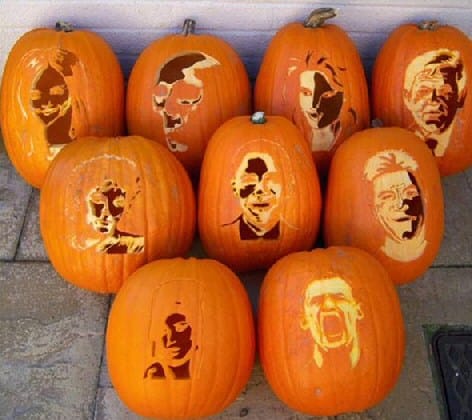
Are you able to determine the celebrity character shown by Will and Guy? [above] These pumpkins have been carved by gardener David Finkle
Rather than carving out the traditional sinister smiles on his prized fruit for Halloween, gardener David Finkle is busy carving out the faces of
his favorite stars for decorative “jack-o’-lanterns.” David, 30, has carved out the faces of X Factor judge Simon Cowell, glamour model Jordan, and Prime Minister, Gordon Brown on the fruits of his labors which grow on his small holding in Chelmsford, Essex, England.
Other celebrity pumpkins he has completed include singer Amy Winehouse, Manchester United and England soccer player, Wayne Rooney, Girls Aloud singer Cheryl Cole, Michael Jackson, and US president Barak Obama.
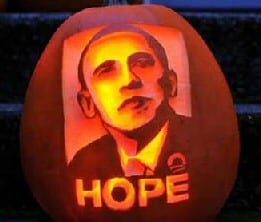
Pumpkin Ghost Rider based on ‘The Legend of Sleepy Hollow’
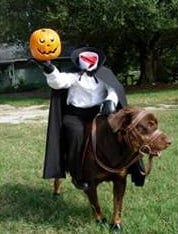
‘The Legend of Sleepy Hollow’ (1820) has spawned generations of headless Horseman with pumpkins at Halloween. As you can imagine from the above picture, the story tells of a suitor being killed by a headless horseman.
Lovely Pumpkin Wall Lanterns
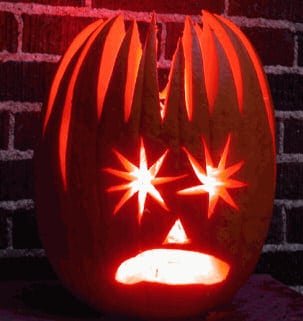
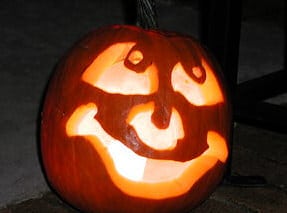
Pumpkin Carving Tip
Before you cut the lid of the pumpkin visualize how to stop the lid falling in later. This means angling the edge of the blade to get a cone shape that bevels away from the middle.
A saw works better than a knife for removing the lid, cut slowly and gently.
See how to make a Jack-o-Lantern
From One Pumpkin to Another!
A co-worker asked Abegale, ‘What is it like to be a Christian?’
Abegale replied, ‘It is like being a pumpkin.’ God picks you from the patch, brings you in, and washes all the dirt off of you. Then He cuts off
the top and scoops out all the yucky stuff.
He removes the seeds of doubt, hate, and greed. Then He carves you a new smiling face and puts His light inside of you to shine for all the
world to see.’
This was passed on to us by another pumpkin called Joe Muise. We liked this enough to send it to all the pumpkins in our patch. Now it’s your turn to pass it to other pumpkins.
Pumpkin and Halloween Stencils
Here are two pumpkin stencils that you can print out.

Pumpkin Carving Tips
- Draw your pumpkin design with a water-based marker, it makes it easier to correct mistakes.
- Cut the top off with a serrated metal saw. Naturally, carve away from your body. Slow steady saw strokes produce the best effect.
- To prevent the lid from falling into the pumpkin make sure that the outer diameter is bigger than the inner.
- Carve the design features closest to the equator first and work outwards.
- Check the height of the candle, you don’t want the flame near the top of the pumpkin.
- A neat trick is to preserve the coat by smearing it with petroleum jelly or vegetable oil and cover your pumpkin with a damp cloth when it’s not on display.
Halloween Jokes and One-liners On Pumpkins
Once you start carving a pumpkin it takes on a life of its own, complete with a sense of humor.
Clean Hallowen Jokes on Pumpkins
- Why Pumpkins are better than Men?
- Each year you get a brand new crop to choose from. Also, pumpkins are always on the doorstep there waiting to greet you.
Speaking with Pumpkins
- How do you talk to a pumpkin with three heads? Hello, hello, hello.
- What did one Jack-o-lantern say to the other? Cut it out!
- What is a pumpkin’s favorite sport? Squash
- Why do Jack-o-lanterns have stupid smiles on their faces? You’d have a stupid smile, too, if you had just had all your brains scooped out!
- What’s the ratio of a pumpkin’s circumference to its diameter? Pumpkin Pi (3.1428571428571428571428571428571)
- What do you get when you cross a snowman and a vampire? Frostbite!
- How do you repair a broken Jack-o-lantern? Buy a pumpkin patch!
- What’s black, white, orange, and waddles? A penguin carrying a Jack-o-lantern.
- Why do pumpkins never quarrel? Because they have no stomach for fighting.
More Funny Halloween Jokes on Pumpkins
These are longer yarns suitable for telling around a campfire.
Best Use of a Pumpkin Patch
John, a city slicker from Boston, bought a pumpkin patch. He thought that he could make more money from chickens than the previous owner
made from pumpkins, so he went to a poultry farm and bought 50 chickens.
’50 is a lot of chickens for that little pumpkin patch,’ commented the proprietor. ‘I am used to big business’ John replied.’
A week later John was back at the farm. ‘I need another 50 chickens,’ he said. ‘Boy, you are serious about this chicken farming,’ the poultry farmer
told him.
‘Oh yes,’ John replied. ‘It’ will be OK if I can just iron out a few problems.’ ‘Problems?’, asked the farmer. ‘Yeah,’ replied John, ‘I think I planted that first batch too close together.’
How to Grow Pumpkins
Farmer Smith was driving his tractor along the road with a trailer load of fertilizer. Alex a little boy of nine was playing ball in his yard; he saw the farmer and asked:
‘What’ve you got in your trailer?’
‘Manure,’ Farmer Smith replied.
‘What are you going to do with it?’ asked Alex.
‘Put it on my pumpkins,’ answered the farmer.
Alex replied, ‘You ought to come and eat with us, we put ice cream on our pumpkin pie.’
Footnote to joke tellers: The above joke works even better if you use ‘Raspberries’, or ‘Strawberries’ instead of ‘pumpkins’ and ‘pumpkin pie’.
Top 10 Pumpkin Sayings
- Pumpkin pie, if rightly made, is a thing of beauty and joy – while it lasts …
- I would rather sit on a pumpkin, and have it all to myself than be crowded on a velvet cushion – Henry David Thoreau
- My favorite word is “pumpkin.” You are a pumpkin. Or you are not. I am. – Harrison E. Salisbury
- To dream of pumpkins is a very bad omen.
- If you’re in a war, instead of throwing a hand grenade at the enemy, throw one of those small pumpkins. Maybe it’ll make everyone think how
stupid war is, and while they are thinking, you can throw a real grenade at them. - I will keep moving forward, forever forward, towards, an endless dream, and a thousand pumpkin lights. – Former President George Bush
- I don’t know about you but my family would stage a mutiny if I didn’t have a pumpkin pie for dessert at Thanksgiving.
- Men are like pumpkins. It seems like all the good ones are either taken or they’ve had everything scraped out of their heads with a spoon.
- Homer Simpson gets into the pumpkin business. ‘This year I invested in pumpkins. They’ve been going up the whole month of October and I got a feeling they’re going to peak right around January.’ …DOH.
- Pumpkin Head, We bought a pumpkin big and round that lived the summer through without an eye to look at things … and now it looks through two. It used to be all dark inside when growing on the vine, but now it has a toothy smile and face that’s full of shine – Aileen Fisher
Pumpkin Deterrent
Mrs. Jones was proud of her pumpkin patch, so she was really disappointed when some of the the local kids were taking them to make Jack-o-Lanterns.
One evening while Mrs Jones was soaking in the bath, the answer to the pumpkin thefts came to her. After supper she went out and put up a sign: ‘Beware, one of these pumpkins is coated with a special colorless rat poison!’
A day or two later when Mrs Jones checked out her pumpkin patch she was pleased to see that no more had been stolen. Then she saw a second sign next to hers which said: ‘NOW THERE ARE TWO!!’
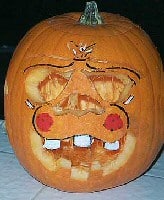
Why Pumpkins Are Better Than Men?
If you don’t like the way your pumpkin looks, you can just carve another face. (Boo say Will and Guy or From the start you know a pumpkin has an empty head. (Boo say Will and Guy again)
Classic Halloween One-liners
- What kind of alley does a ghost prefer to haunt? A dead end.
- Why wasn’t the vampire working? He was on his coffin break.
- What’s a ghost’s favorite ride at the carnival? The roller ghoster
- What did the mother ghost say to the baby ghost? Fasten your sheet belt.
More Halloween Gags
- What is a vampire’s favorite type of ship? A blood vessel.
- What was a witch’s favorite subject when they were in school? Spelling!
- What musical instrument does a skeleton play? A trombone.
- Why don’t skeletons like parties? They have no body to dance with.
- Why did the mummy call the doctor? Because her baby was coffin.
Halloween Pumpkin Choir
A Scary Coven of Pumpkins (13)

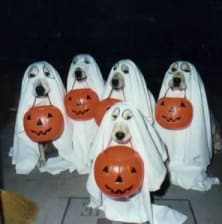
Pumpkins, witches, haunted houses
School Logo – Witch on a Broomstick

The flying witch appears on the pupils’ sports kit and uniforms of Warboys Community Primary School and has been used for the last 60 years. However, Will and Guy have discovered that some pupils and even some teachers have avoided the school because of this ‘scary’ logo. Opinions in the village are running high and over 1000 signatures have been obtained on a petition to keep the historic emblem.
The historical background to the witch motif is that Warboys is the last recorded place in England where witches were hanged. Apparently, Alice Samuels, her husband John, and her daughter Agnes were executed in 1593 after being accused by a 10-year-old girl, her four sisters, and servants of causing them to have fits.
A spokesperson has stated, ‘Witchcraft and Haloween does not form part of the school curriculum and is something schools go out of their way to avoid. The school is aware that some parents choose not to send their children to Warboys and cite the witch as one of the reasons why.’
Martin Kelsey, the head teacher responsible for improving standards at the school, admitted, ‘From the villagers’ point of view, it’s an emotive issue because they are very, very proud of their history.’
However, we have learned that the school governors seem determined to get rid of the logo as part of measures to give it a “fresh start” after poor inspection reports.
Scary Halloween Poems
A Chilling Halloween Poem
I’m not afraid of snakes, or toads, or bugs, or worms, or mice,
The things that girls are scared of, I think are awful nice.
I’m pretty brave, I guess, and yet I hate to go to bed,
For, when I’m tucked up warm and snug and when my prayers are said,
Mother tells me “Happy dreams!”
and takes away the light,
And leaves me lying all alone and seeing things at night.
Sometimes they’re in the corner, sometimes they’re by the door,
Sometimes they all just creep and crawl across the bedroom floor;
Sometimes they come when I’m asleep, sometimes when I’m awake
So softly and so silently, they make me scream and shake.
Sometimes they are as black as ink, and other times they’re white
But color makes no difference when you’re seeing things at night.
Once, Mother caught me being bad, fighting in the street,
And Father sent me up to bed without a bite to eat.
I heard some noises in the dark and up my ears did prick
Those things were gathered all around and planning something sick.
I was so very scared that time, I got an awful fright
It’s always when I’m bad that I start seeing things at night.
Lucky thing I’m not a girl, or I’d be scared to death.
Since I’m a boy, I duck my head and then I hold my breath.
When I hear something horrible, crawling up the stairs
I promise to be better and I always say my prayers.
I’m certain that’s the only way that I can make it right
When I’ve been very wicked and start things at night!
And so, when other evil kids tempt and coax me into sin,
I try to squash the devil’s voice that urges me within.
At night the things creep closer and they aren’t very nice,
They want to eat me up without even thinking twice!
Eventually, these evil things will drag me out of sight
I hope I don’t keep doing wrong, and seeing things at night!
Author Unknown
Pumpkin Head
We bought a pumpkin big and round that lived the summer through without an eye to look at things … and now it looks through two.
It used to be all dark inside when growing on the vine, but now it has a toothy smile and face that’s full of shine.







